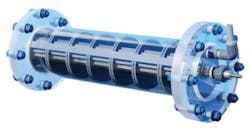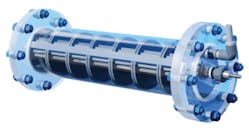By Glen Smith
Drinking water treatment plants use various forms of chlorine to inactivate pathogens, oxidize metals or metalloids and provide disinfection residual for distribution systems. Recent concerns of safety for chlorine gas and high strength sodium hypochlorite have made on-site generation of sodium hypochlorite an attractive option.
On-site generation typically produces NaOCl at concentrations of under 1%. Electrochemical cells such as the Pepcon Systems BP III generates NaOCl at 0.8%. The translucent BP III cell uses a brine solution and DC current, about 2.5 kWh, to produce a pound of equivalent chlorine. A single cell will generate up to 180 lbs. /day. Up to 500 lbs./day equivalent chlorine can be achieved from a 36”x 50” x 72”H three-cell module. Larger capacities are configured using multiple module systems.
The BP III cell including its titanium anodes and cathodes has been certified to ANSI/NSF Standard 61 (Indirect Additives for Drinking Water). The system will be on display at ACE11.
Electrolytic chlorinators can be designed to generate continuous or batch supplies depending on system needs. Low concentration hypochlorite is least affected by temperature change and storage time, and chlorate formation is minimized. With OSG units there is always a trade off between power and salt costs. If power cost was the only consideration OSG manufacturers would produce the lowest concentration of NaOCl possible with the highest salt/brine concentration.
OSG systems may often need cooling depending on the supply water temperature. This is due to the well known fact that some degradation of NaOCl occurs at temperatures approaching 38-40°F. This cooling is typically accomplished by using a chiller to cool the water/brine supply to the cell.
Venting of hydrogen produced by the electrochemical process is a factor and it is vitally important to keep concentrations well below the 4% threshold limit. This is accomplished by diluting the hydrogen with dilution air produced by blowers. The flammability limits based on the volume percent of hydrogen in air at 14.7 psia are 4.0% and 75.0%. The flammability limits based on the volume percent of hydrogen in oxygen at 14.7 psia are 4.0 and 94.0.
Utilities should review state and local regulations with their engineering consultant when making decisions regarding the use of liquid chlorine, appropriate concentrations, dosing methods and secondary containment requirements.
Since typical potable water contains hardness, (calcium) it is advisable to soften the water that is being used to make the brine solution feeding the system. If feed water is not softened, scaling of the electrodes will occur as a result of a change in pH within the electrochemical process. Scaling will negatively impact the efficiency of the system.
Controls
With any of the above process technologies, adequate control of dosing into the treatment process is imperative to maintain the desired residual. Traditional dosing control techniques have included simple on-off control, flow pacing, residual feed back and compound loop control (a combination of flow pacing with residual dosage trim). But, with all forms of chlorine, especially when using NaOCl, other factors come into play that impact control.
Operators should keep analyzer lag times as short as possible. Best practice suggests that chlorine residual analyzers be located as close to the sampling point as possible. They should maintain consistency in salt brine solution and monitor the consistency of salt quality, which can vary. Operators should also develop and maintain an adequate maintenance program.
About the Author: Glen Smith is Director of Engineering and Sales at PEPCON Systems, a division of AMPAC. He can be contacted at [email protected].
PEPCON SYSTEMS® is an exhibitor at the ACE® ‘11 event and can be found at Booth No. 441
Circle No. 398 on Reader Service Card
More WaterWorld Current Issue Articles
More WaterWorld Archives Issue Articles




